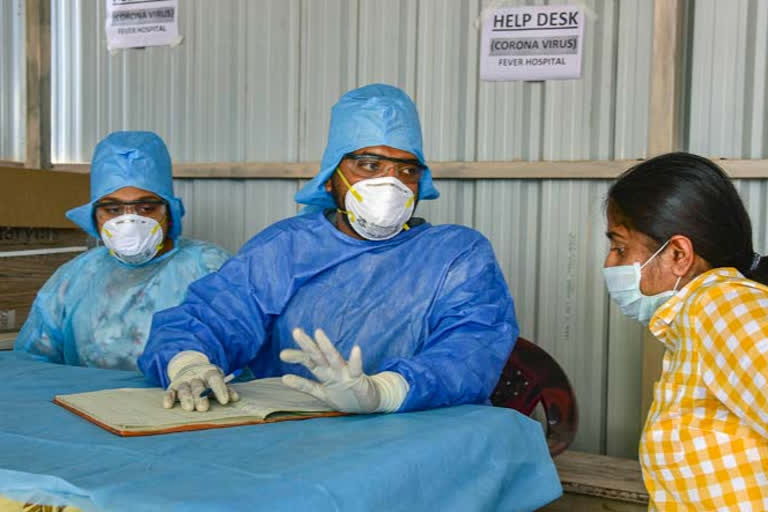New Delhi: India is going through a public health crisis of an unprecedented magnitude. Never has a health calamity brought the nation to a complete halt. Lockdown was an alien word for most Indians.
Many, perhaps, realised the meaning of the word on March 22 when the Prime Minister Narendra Modi gave a call for a nationwide day-long lockdown to check the spread of coronavirus or COVID-19 and to honour the healthcare and sanitation workers, and the security personnel for their selfless services.
While the country was racing against time to deal with Coronavirus pandemic as the number of cases increased steadily from March, the government came across another crisis when the authorities at the Nigambodh Ghat refused to cremate the body of a 68-year-old woman who had died of Covid-19 on March 13, in the absence of clear guidelines on handling such bodies.
The cremation was finally done at the electric crematorium following the intervention of the doctors from the RML Hospital where she was admitted for treatment. The matter was taken up by media as the family waited endlessly at the cremation ground prompting the authorities to intervene.
This was not the lone case. In a Bihar village, the body of a person who had died of COVID-19 was kept at home for a very long time for family to pay the last rites.
A huge crowd had gathered at the house following which the entire village had to be quarantined. In Kolkata, the family members of another victim did not turn up to claim the body and the crematorium people refused to let the last rites be performed fearing infection. The body was finally cremated in the electric crematorium after a delay of 10 hours.
The Ministry of Health and Family Welfare put out guidelines for handling, transportation and cremation of bodies of the people having died of COVID-19.
Even the guidelines for dead body management towards precautions, infection prevention and control measures, handling of body and environmental disinfection were issued, there were some concerns since most of the bodies in India are cremated in the open.
Though cities have facilities of electric crematoria, in districts and villages cremations are done in the open and along the banks of rivers which may pose a risk of environmental contamination, if bodies are not handled as per defined protocols.
Focussing on sensitisation of crematorium/burial ground staff that COVID-19 does not pose an additional risk of infection, the guidelines said the staff would, however, have to practice standard precautions of hand hygiene, use of masks and gloves.
Viewing of the dead body by unzipping the face end of the body bag (by the staff using standard precautions) may be allowed, for the relatives to see the body for one last time and allowing religious rituals such as reading from religious scripts, sprinkling holy water and any other last rites that does not require touching of the body, the guidelines strictly disallow bathing, kissing, and hugging, of the dead body.
The funeral/ burial staff and family members should perform hand hygiene after cremation/ burial.
According to the guidelines, the ash does not pose any risk and can be collected to perform the last rites. However, large gathering at the crematorium/ burial ground should be avoided as a social distancing measure as it is possible that close family contacts may be symptomatic and/ or shedding the virus, the guidelines said.
While the Ministry of Health and Family Welfare claimed there was unlikely to be an increased risk of infection from a dead body of a coronavirus patient to health workers or family members who follow standard precautions including gloves and masks, as the main driver of transmission of COVID-19 is through droplets.
Admitting that the guidelines stated that there is knowledge gap on how to dispose off the dead body of a suspect or a confirmed case of COVID-19, the government said it is based on the current epidemiological knowledge about the disease.
Place the dead body in a leak-proof plastic body bag. The exterior of the body bag can be decontaminated with one percent hypochlorite. The body bag can be wrapped with a mortuary sheet or sheet provided by the family members.
The guidelines are a welcome and timely move. However, the government would have to ensure these guidelines are sent to and practices in letter and spirit when needed. The facilities for transportation and sanitisation of vehicles would have to be provided and, importantly, the staff sensitised and trained.
It is also imperative for the administrations, at various levels, to inform and educate the masses about these protocols. These should be part of the larger media sensitisation campaign which is being undertaken by the government on hand washing, use of sanitisers and staying indoors.
India has appreciably managed the outbreak and deaths so far. Cremation is not an issue as long as mortality remains low, but in such unprecedented and unpredictable situations, nothing can be taken for granted.
Hence, India should be prepared on this count as well and must include this component in its campaign against COVID-19.
Being prepared is better than being caught napping, and India has proven it so far it has the capacity and the political will to do.
Also read: Can we rescue Indian Democracy?



